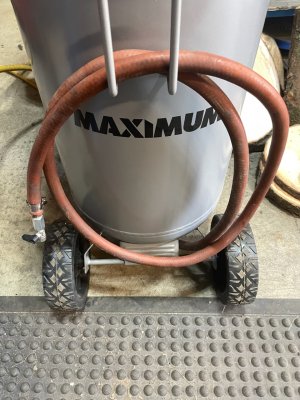-
Scam Alert. Members are reminded to NOT send money to buy anything. Don't buy things remote and have it shipped - go get it yourself, pay in person, and take your equipment with you. Scammers have burned people on this forum. Urgency, secrecy, excuses, selling for friend, newish members, FUD, are RED FLAGS. A video conference call is not adequate assurance. Face to face interactions are required. Please report suspicions to the forum admins. Stay Safe - anyone can get scammed.
You are using an out of date browser. It may not display this or other websites correctly.
You should upgrade or use an alternative browser.
You should upgrade or use an alternative browser.
Crack in Air Compressor tank…
- Thread starter StevSmar
- Start date
Tom Kitta
Ultra Member
You can get new-ish or new 1ph compressors on auction often for less than 1/2 price new. Sometimes 1/4.
You could weld it for fun and test it but that is if you are somehow low on projects. Besides, it will crack again soon - so not very good use of resources. You could try to find new tank for it as well - on auction a 20 gallon tanks are usually used - but occasionally you find a new one - given its a tank no compressor price would be around $10.
You could weld it for fun and test it but that is if you are somehow low on projects. Besides, it will crack again soon - so not very good use of resources. You could try to find new tank for it as well - on auction a 20 gallon tanks are usually used - but occasionally you find a new one - given its a tank no compressor price would be around $10.
slow-poke
Ultra Member
After watching the exploded compressor video, and considering how old my compressor is I decided to watch a few videos an read a bit to get informed. As usual random information via Google search is not always accurate, so by all means please chime in if the summary below is inaccurate.
1) Older tanks tend to be thicker than newer tanks, in some cases a 40 YO tank may have more un-rusted thickness than a brand new tank. Comparing weight can give some insight.
2) If it does not have an ASME certification tag you really have no idea what you're getting.
3) Most of the time a failing tank will develop a pin hole leak before actually exploding. Attempting to repair often leads to the explosive results, so just don't do it.
I'm going to replace my old 20 gallon Campbell Hausfeld, so if anyone has any suggestions I'm listening.
1) Older tanks tend to be thicker than newer tanks, in some cases a 40 YO tank may have more un-rusted thickness than a brand new tank. Comparing weight can give some insight.
2) If it does not have an ASME certification tag you really have no idea what you're getting.
3) Most of the time a failing tank will develop a pin hole leak before actually exploding. Attempting to repair often leads to the explosive results, so just don't do it.
I'm going to replace my old 20 gallon Campbell Hausfeld, so if anyone has any suggestions I'm listening.
Last edited:
Comparing weight can give some insight.
My only concern in what you wrote is the statement above. Since all weigh scales except very expensive lab grade scales are pure crap (in my opinion and experience), and since rusty metal prolly weighs more than virgin metal, and since removing rusty crust is probably an exercise in futility, I could never trust weight change as an indicator of changing tank condition.
slow-poke
Ultra Member
I was not implying weight change, just weight based on size. Take two 50 gallon compressors and one weighs 75 lbs more it in all likelihood it has a thicker tank.My only concern in what you wrote is the statement above. Since all weigh scales except very expensive lab grade scales are pure crap (in my opinion and experience), and since rusty metal prolly weighs more than virgin metal, and since removing rusty crust is probably an exercise in futility, I could never trust weight change as an indicator of changing tank condition.
Q
Higher Tank weight for the same volume is usually good!
I suppose the exception would be some outfit mismatching head and cylinder thickness. But presumably the code (which I have long forgotten) would preclude that.
Gotcha! I misunderstood.I was not implying weight change, just weight based on size. Take to 50 gallon compressors and one weighs 75 lbs more it in all likelihood it has a thicker tank.
Higher Tank weight for the same volume is usually good!
I suppose the exception would be some outfit mismatching head and cylinder thickness. But presumably the code (which I have long forgotten) would preclude that.
That tank really split catastrophically. Some of the comments said he never drained it and welded up some pinholes?Buy a new unit.
slow-poke
Ultra Member
From the videos I watched the welding the tank approach seems to be the magic ticket to a future explosion. Compressor expert guy claimed the tanks are heat treated after they are all welded up, and welding repair significantly weakens the tank. If I had a pinhole leak, it would never see pressure again, that just seems stupid.That tank really split catastrophically. Some of the comments said he never drained it and welded up some pinholes?
Proxule
Ultra Member
drain your tank. No big deal!
Buy a new unit.
Thanks for posting!
FatherWes
Wes
I suspect newer tanks are higher strength steel, allowing for thinner metal, and less weight/cost. But the higher strength adds nothing to corrosion allowance and the higher stresses-thinner wall will amplify stress risers around a flaw.
The higher stength steels also require more stringent welding procedures which may include pre and/or post weld heat treat.
Welding up a pinhole does nothing to fix the loss if wall thickness, often a groove along the bottom of the tank where the water has been sitting. The pinhole might have only had an extra 20 thou of corrosion.
I welded up my previous tank. Worked great until I admitted it was a stupid idea and took it out of service.
Repair can be done. But by the time you scope out the extent of the corrosion and then do the repair properly per ASME, a new compressor starts looking pretty attractive.
The higher stength steels also require more stringent welding procedures which may include pre and/or post weld heat treat.
Welding up a pinhole does nothing to fix the loss if wall thickness, often a groove along the bottom of the tank where the water has been sitting. The pinhole might have only had an extra 20 thou of corrosion.
I welded up my previous tank. Worked great until I admitted it was a stupid idea and took it out of service.
Repair can be done. But by the time you scope out the extent of the corrosion and then do the repair properly per ASME, a new compressor starts looking pretty attractive.
That makes perfect sense to me. You can weld your tank if you don’t add stress risers while welding and if you stress relieve it and and if etc…Compressor expert guy claimed the tanks are heat treated after they are all welded up, and welding repair significantly weakens the tank.
I’d always be wary of a tank that was repaired. I kick myself for not having chased down the source of the air leakage a long time ago.
Shortly after seeing this discussion- i did as @David_R8 and installed a drain extension. Was easy to install and easy to use. Now i drain whenever i shut it off. Before, when i drained it occasionally, the water looked disgusting, yellow/brown and lumpy. Now with daily drains - it is clean looking water. @Susquatch asked what is best practice - my answer is ‘make it simple and do it often’
(The hose in the pic is the drain hose)
(The hose in the pic is the drain hose)
Attachments
I’ve been using my compressors the last few days to run my air nibbler (scaler- in pic below to chip paint). Takes a lot of air and both compressors in tandem are all out to hold 60psi. (4cfm and a 2.4cfm connected to a small header). I noticed the larger one was getting hot. (Probably too hot and beyond it’s duty cycle - but no duty cycle mentioned in the manual.)
I installed a cooling fan on the larger compressor (used an old bathroom vent fan i think is 150cfm). It worked great to bring down the operating temperature and also improved the time to cool down.
Might be a bit hard to see the install in the photo - before attaching the fan I cut and bent the top of the compressor steel cover to deflect the air flow (right, left and straight down).
Before the fan install the compressor reached 270 degrees F (15minutes and near steady state). After the fan install the max temp was 191 F. It also, as would be expected, cooled down much quicker.
The King Canada 2.4cfm Flex-Air max temp was 180F (during the same test) - so i don’t think I’ll bother with an auxiliary fan for it. By the way - the Flex-Air is great and very quiet.
(Attached pics are of the nibbler, the temperature spread sheet, and the fan install)
I installed a cooling fan on the larger compressor (used an old bathroom vent fan i think is 150cfm). It worked great to bring down the operating temperature and also improved the time to cool down.
Might be a bit hard to see the install in the photo - before attaching the fan I cut and bent the top of the compressor steel cover to deflect the air flow (right, left and straight down).
Before the fan install the compressor reached 270 degrees F (15minutes and near steady state). After the fan install the max temp was 191 F. It also, as would be expected, cooled down much quicker.
The King Canada 2.4cfm Flex-Air max temp was 180F (during the same test) - so i don’t think I’ll bother with an auxiliary fan for it. By the way - the Flex-Air is great and very quiet.
(Attached pics are of the nibbler, the temperature spread sheet, and the fan install)
Attachments
-
 ACC5E523-724F-4722-AC7B-7F1D8C60136D.jpeg102 KB · Views: 15
ACC5E523-724F-4722-AC7B-7F1D8C60136D.jpeg102 KB · Views: 15 -
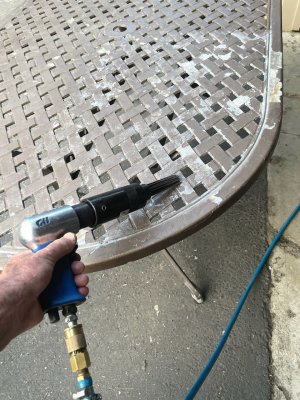 9CA92ACA-8AC5-484E-9290-663608F27F7B.jpeg273.4 KB · Views: 15
9CA92ACA-8AC5-484E-9290-663608F27F7B.jpeg273.4 KB · Views: 15 -
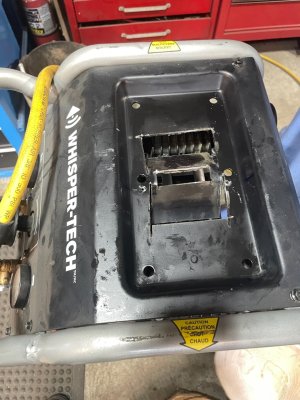 83A2EDEF-DE5B-40C6-9249-E251A2D37F26.jpeg183.3 KB · Views: 13
83A2EDEF-DE5B-40C6-9249-E251A2D37F26.jpeg183.3 KB · Views: 13 -
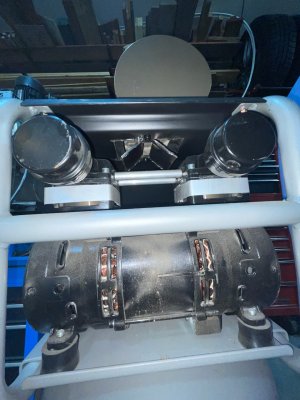 DDA319D6-170B-45C1-B6D3-B93BDB844B04.jpeg169.7 KB · Views: 13
DDA319D6-170B-45C1-B6D3-B93BDB844B04.jpeg169.7 KB · Views: 13 -
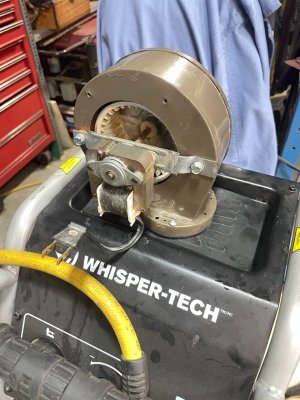 00811B46-FADE-407A-A937-329C54BC7926.jpeg194.7 KB · Views: 14
00811B46-FADE-407A-A937-329C54BC7926.jpeg194.7 KB · Views: 14
FatherWes
Wes
Great stuff! A little cooling in compression has huge impact.
I was looking at the thermodynamics of my air compressor. I was shocked when I looked at the expected discharge temperature. WAY too high. Not that surprising when you consider it’s about 9 to 1 compression ratio in a single stage.
I’m amazed at how effective the cooling fins and flywheel/v-belt sheave/cooling fan obviously are. I definitely blew the dust off the cooling fins the next time I was in the shop!!
I’m also amazed that I’ve never looked at this before.
I was looking at the thermodynamics of my air compressor. I was shocked when I looked at the expected discharge temperature. WAY too high. Not that surprising when you consider it’s about 9 to 1 compression ratio in a single stage.
I’m amazed at how effective the cooling fins and flywheel/v-belt sheave/cooling fan obviously are. I definitely blew the dust off the cooling fins the next time I was in the shop!!
I’m also amazed that I’ve never looked at this before.
Quincy no longer makes replacement tanks for my air compressor, so now I get to decide:
a) Purchase a new compressor.
b) Find a replacement tank, maybe a vertical one.
c) Get a small oil less quiet compressor for inflating tires and air nailer use etc.
The good thing is that to get my Mill stand ready for painting, I bought a variable speed, electric, die grinder. I think it’s going to get quite a lot of use in both metalworking and woodworking.
a) Purchase a new compressor.
b) Find a replacement tank, maybe a vertical one.
c) Get a small oil less quiet compressor for inflating tires and air nailer use etc.
The good thing is that to get my Mill stand ready for painting, I bought a variable speed, electric, die grinder. I think it’s going to get quite a lot of use in both metalworking and woodworking.
Former Member
Guest
There used to be an article online (sorry don't remember the reference) which talks about the advantages of vertical vs horizontal tanks and which fail first and why.
Second I am surprised by how much moisture I drain regularly from my system on the tank alone (60gal vertical). I am going to install a pre-cooler/moisture trap between the pump and tank that should remove 99.5% of the moisture before getting to the tank. Better for the tank and better for the air-system as it will result in dry air through-out while reducing the final drying load.
Second I am surprised by how much moisture I drain regularly from my system on the tank alone (60gal vertical). I am going to install a pre-cooler/moisture trap between the pump and tank that should remove 99.5% of the moisture before getting to the tank. Better for the tank and better for the air-system as it will result in dry air through-out while reducing the final drying load.
Last edited:
I did a bit of searching, it certainly appears that horizontal tanks explode more often than vertical:There used to be an article online (sorry don't remember the reference) which talks about the advantages of vertical vs horizontal tanks and which fail first and why.
Hobby Machinist- Horizontal versus Vertical tanks
And the link on page 6 to an article showing failures (all of which appear to be horizontal (one shows the wall damage but not the compressor)):
Metropolitan Engineering Consultants: CAUSE OF EXPLOSION OF AIR COMPRESSOR TANKS
I think I’ll soon be in the same boat.20V tools have obsoleted all my air tools, I hate painting, and I don't have a sandblaster.
I don’t mind painting, but it’s always a pain because I’m not set up for it.

